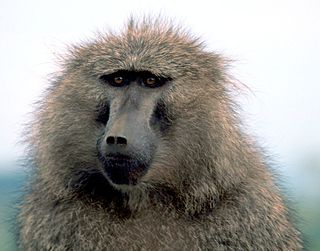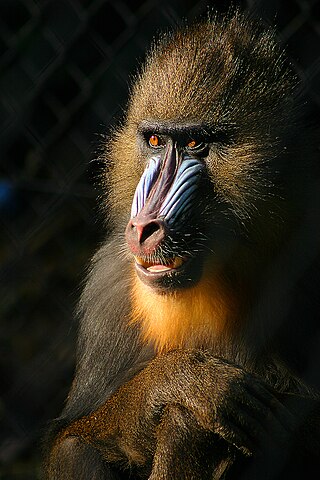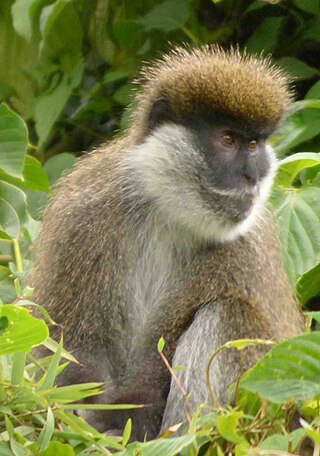Early life
Isbell grew up in Compton, California. [1] At school, she had the ambition to become a veterinarian, but was inspired to take an interest in primatology by Jane Goodall’s book In the Shadow of Man (1971). [2]
In Black, Brown, and White: Stories Straight Outta Compton, written with two friends from different ethnic backgrounds, Isbell has written about their lives in Compton during the 1960s and early 1970s, the era of the civil rights movement, the Watts riots, and black power. They describe how Compton changed from a mostly white community to a mostly black one that was known as "the Murder Capital of the United States." [1] The title refers to Straight Outta Compton , an album by N.W.A.
As an undergraduate at the University of Redlands, Isbell worked with ungulates, including bongos and desert bighorn sheep, [2] and graduated BA in ethology from Johnston College of the University in 1976. [3]
Isbell’s focus on primates came after moving to Davis, California, when she volunteered to work on a year-long behavioral project with captive bonnet macaques. [2] She spent two years in the field at Tom Struhsaker's study site in Uganda before entering graduate school at UC Davis, planning a dissertation on the behavior and ecology of the red colobus monkey, but took the opportunity instead to study vervet monkeys. After fieldwork in the Amboseli National Park, Kenya, she received a PhD from UC Davis in 1990, [3] with a dissertation on "Influences of Predation and Resource Competition on the Social System of Vervet Monkeys (Cercopithecus aethiops) in Amboseli National Park, Kenya" supervised by Peter Rodman. [2]
Career
Isbell's first academic job was as reader for the class of Meredith Small. [2] She gained her Ph.D. in Animal Behavior from UC Davis in 1990. [3]
She was an Assistant Professor at Rutgers University from 1992 to 1996 and has been at University of California, Davis, since 1996, where she is currently a full professor. Her field of research is primate behavior, ecology, and evolutionary history, [3] with focuses on aspects of food competition, predation, dispersal, and ranging behaviour. [2]
Apart from Isbell's long-term fieldwork in Kenya and Uganda, she has also carried out shorter-term work in Tanzania, the Democratic Republic of Congo, Madagascar, and Rwanda. [2]
Isbell has published work on the origin of primates, on predation, food competition, the ecology of social relationships, the evolution of group living, and bipedalism [3] and is the author of an award-winning book, The Fruit, the Tree, and the Serpent: Why We See So Well (2009), [2] which proposes the snake detection theory, largely attributing the advanced evolution of the visual system of primates to the need to detect snakes.
In 2022, Isbell was elected a Fellow of the American Association for the Advancement of Science (AAAS) [4]

Primates is an order of mammals, which is further divided into the strepsirrhines, which include lemurs, galagos, and lorisids; and the haplorhines, which include tarsiers; and the simians, which include monkeys and apes. Primates arose 85–55 million years ago first from small terrestrial mammals, which adapted for life in tropical forests: many primate characteristics represent adaptations to the challenging environment among tree tops, including large brain sizes, binocular vision, color vision, vocalizations, shoulder girdles allowing a large degree of movement in the upper limbs, and opposable thumbs that enable better grasping and dexterity. Primates range in size from Madame Berthe's mouse lemur, which weighs 30 g (1 oz), to the eastern gorilla, weighing over 200 kg (440 lb). There are 376–524 species of living primates, depending on which classification is used. New primate species continue to be discovered: over 25 species were described in the 2000s, 36 in the 2010s, and six in the 2020s.

Primatology is the scientific study of non-human primates. It is a diverse discipline at the boundary between mammalogy and anthropology, and researchers can be found in academic departments of anatomy, anthropology, biology, medicine, psychology, veterinary sciences and zoology, as well as in animal sanctuaries, biomedical research facilities, museums and zoos. Primatologists study both living and extinct primates in their natural habitats and in laboratories by conducting field studies and experiments in order to understand aspects of their evolution and behavior.

Sarah Hrdy is an American anthropologist and primatologist who has made major contributions to evolutionary psychology and sociobiology. She is considered "a highly recognized pioneer in modernizing our understanding of the evolutionary basis of female behavior in both nonhuman and human primates". In 2013, Hrdy received a Lifetime Career Award for Distinguished Scientific Contribution from the Human Behavior and Evolution Society.

The common patas monkey, also known as the hussar monkey, is a ground-dwelling monkey distributed over semi-arid areas of West Africa, and into East Africa.

Old World monkeys are primates in the family Cercopithecidae. Twenty-four genera and 138 species are recognized, making it the largest primate family. Old World monkey genera include baboons, red colobus and macaques. Common names for other Old World monkeys include the talapoin, guenon, colobus, douc, vervet, gelada, mangabey, langur, mandrill, surili (Presbytis), patas, and proboscis monkey.

The vervet monkey, or simply vervet, is an Old World monkey of the family Cercopithecidae native to Africa. The term "vervet" is also used to refer to all the members of the genus Chlorocebus. The five distinct subspecies can be found mostly throughout Southern Africa, as well as some of the eastern countries. These mostly herbivorous monkeys have black faces and grey body hair color, ranging in body length from about 40 cm (16 in) for females, to about 50 cm (20 in) for males.

The Cercopithecinae are a subfamily of the Old World monkeys, which comprises roughly 71 species, including the baboons, the macaques, and the vervet monkeys. Most cercopithecine monkeys are limited to sub-Saharan Africa, although the macaques range from the far eastern parts of Asia through northern Africa, as well as on Gibraltar.

In animal communication, an alarm signal is an antipredator adaptation in the form of signals emitted by social animals in response to danger. Many primates and birds have elaborate alarm calls for warning conspecifics of approaching predators. For example, the alarm call of the blackbird is a familiar sound in many gardens. Other animals, like fish and insects, may use non-auditory signals, such as chemical messages. Visual signs such as the white tail flashes of many deer have been suggested as alarm signals; they are less likely to be received by conspecifics, so have tended to be treated as a signal to the predator instead.

De Brazza's monkey is an Old World monkey endemic to the riverine and swamp forests of central Africa. The largest species in the guenon family, it is one of the most widespread arboreal African primates. Aside from size, it can be differentiated from other Cercopithecus monkeys by its orange diadem and white beard. Due to its cryptic nature, the species is not well documented in all of its habitats but has shown unique traits, such as pair-bonding and aggressive behavior towards other guenons.
The Primate Research Institute, Kyoto University is a Japanese research center for the study of primates. It was founded in 1967 by primatologists Kinji Imanishi and Junichiro Itani. The institute works toward understanding the biological, behavioral and socioecological aspects of primates, and the origin and evolution of humans. The institute is located in the city of Inuyama, Aichi Prefecture, which is about 150 km east of the main campus of Kyoto University. Through the Division of Biological Sciences of the Graduate School of Science of Kyoto University, the institute offers graduate programs leading to the Master of Science and Doctorate of Science degrees in the field of primatological science. Since 2013, the director of the institute is botanist Hirohisa Hirai.

L'Hoest's monkey, also known as the mountain monkey, is a guenon found in the upper eastern Congo basin. They mostly live in mountainous forest areas in small, female-dominated groups. They have a dark coat and can be distinguished by a characteristic white beard.

The moustached guenon or moustached monkey is a species of primate in the family Cercopithecidae. It is found in Angola, Cameroon, Central African Republic, Republic of the Congo, Democratic Republic of the Congo, Equatorial Guinea, and Gabon.

The Bale Mountains vervet is a terrestrial Old World monkey endemic to Ethiopia, found in the bamboo forests of the Bale Mountains. All species in Chlorocebus were formerly in the genus Cercopithecus. The Bale Mountains vervet is one of the least-known primates in Africa. They avoid tree-dominated and bushland areas as their habitat. These monkeys mainly reside in the bamboo forest of the Bale Mountains due their dietary specialization on bamboo, but other factors, such as climate, forest history, soil quality, and disease, are likely to play a role in their choice to inhabit this area. The Bale Mountains vervet have a very quiet behavior and tend to flee when encountering a human being. It is also known as the Bale monkey and Bale Mountain grivet.

The American Journal of Primatology is a monthly peer-reviewed scientific journal and the official journal of the American Society of Primatologists. It was established in 1981 and covers all areas of primatology, including the behavioral ecology, conservation biology, evolutionary biology, life history, demography, paleontology, physiology, endocrinology, genetics, molecular genetics, and psychobiology of non-human primates. Besides its regular issues, the journal publishes a yearly supplementary issue detailing the program of the society's annual meetings. The editor-in-chief is Karen Bales. The types of papers published are: original research papers, review articles, book reviews, commentaries, and plenary addresses.
Michael J. Owren was a Norwegian born American psychologist who contributed to the understanding of animal communication, the evolution of language, emotional communication, and vocal acoustics. His work focused on vocal phenomena in animals and humans. He pioneered digital spectral analysis techniques, first developed in speech science, for use in studies of animal communication. He studied primate vocalizations in terms of acoustics and communicative functions.
Susan C. Alberts is an American primatologist, anthropologist, and biologist who is the current Chair of the Department of Evolutionary Anthropology at Duke University; previously, she served as a Bass fellow and the Robert F. Durden Professor of Biology at Duke. She currently co-directs the Amboseli Baboon Research Project with Jeanne Altmann of Princeton University. Her research broadly studies how animal behavior evolved in mammals, with a specific focus on the social behavior, demography, and genetics of the yellow baboon, although some of her work has included the African elephant. She was elected a fellow of the American Academy of Arts and Sciences in 2014, won the Cozzarelli Prize of the National Academy of Sciences in 2016, and was elected a fellow of the National Academy of Sciences in 2019.

The red-tailed monkey, also known as the black-cheeked white-nosed monkey, red-tailed guenon, redtail monkey, or Schmidt's guenon, is a species of primate in the family Cercopithecidae.
Dorothy Leavitt Cheney was an American scientist who studied the social behavior, communication, and cognition of wild primates in their natural habitat. She was Professor of Biology at the University of Pennsylvania and a member of both the US National Academy of Sciences and the American Academy of Arts and Sciences.
Robert M. Seyfarth is an American primatologist and author. With his wife and collaborator Dorothy L. Cheney, he spent years studying the social behavior, communication, and cognition of wild primates in their natural habitat, including more than a decade of field work with baboons in the Okavango Delta of Botswana. Seyfarth, a professor of psychology at the University of Pennsylvania until his retirement, is a member of both the United States National Academy of Sciences and the American Academy of Arts and Sciences.
The southern patas monkey is a critically endangered species of Old World monkey found only in Tanzania, and formerly in Kenya. It may be the most endangered primate in Africa known to still be extant, with only 100 to 200 known wild individuals.














